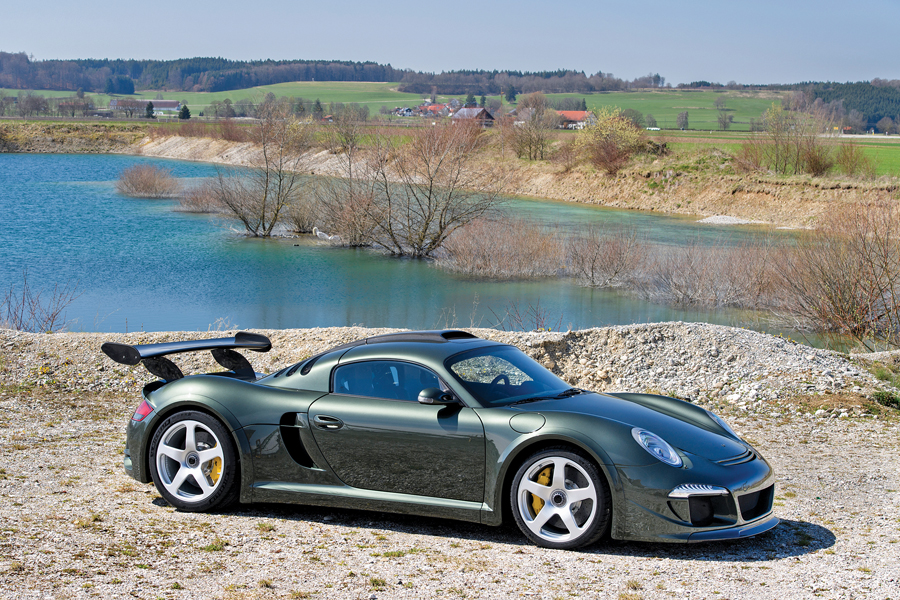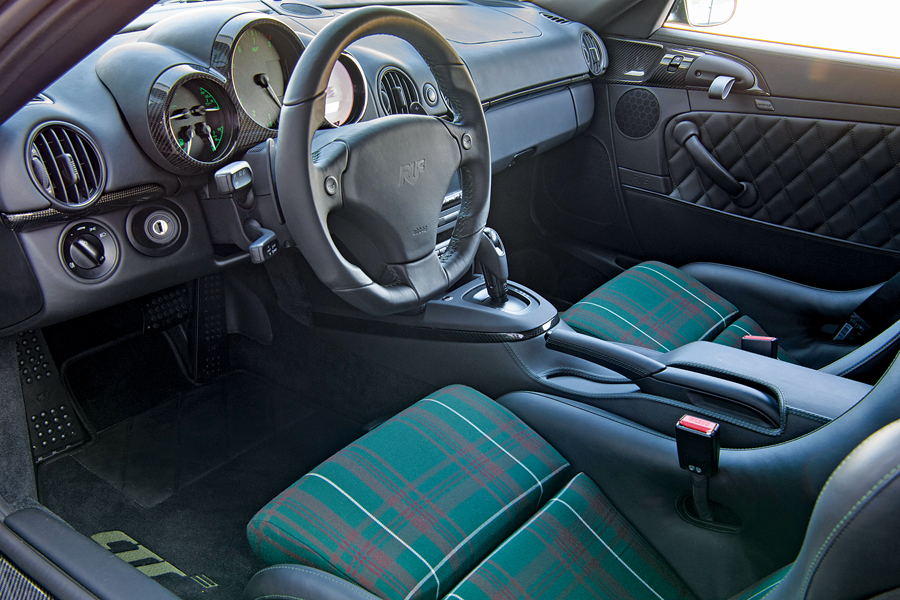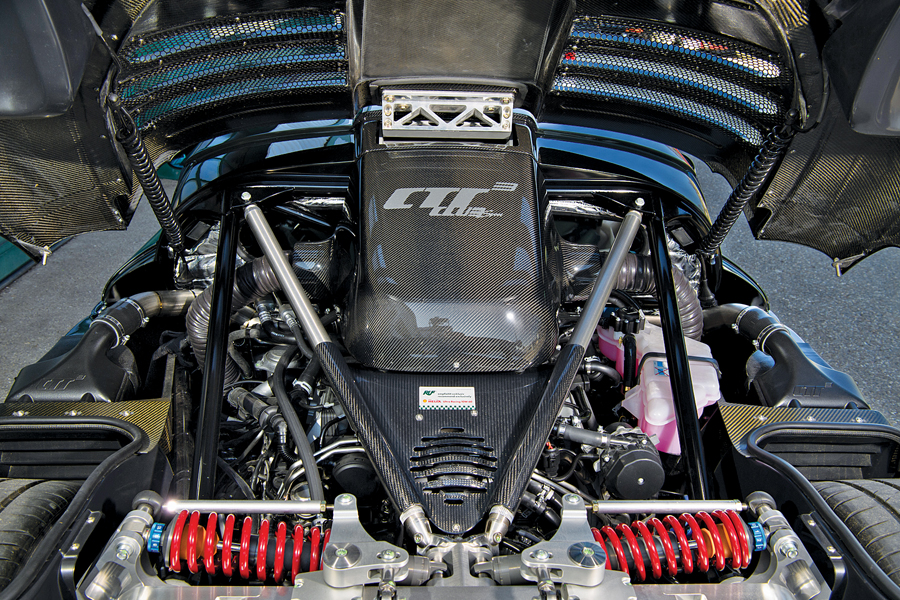SCM Analysis
Detailing
| Vehicle: | 2018 RUF CTR3 Clubsport |
| Years Produced: | 2007–18 |
| Number Produced: | 30 total; seven of them are Clubsports |
| Original List Price: | $725,000 |
| SCM Valuation: | $1,321,691 (this car) |
| Tune Up Cost: | $3,000-plus |
| Chassis Number Location: | Tag inside driver’s door facing rear jamb; tag at base of driver’s side windshield |
| Engine Number Location: | At front of engine on vertical case casting |
| Club Info: | Porsche Club of America |
| Website: | http://www.pca.org |
| Alternatives: | 2013–15 Porsche 918 Spyder, 2013–15 McLaren P1, 2018 Mercedes-AMG GT R |
| Investment Grade: | B |
This car, Lot 159, sold for $1,321,691, including buyer’s premium, at RM Sotheby’s Monaco auction on May 12, 2018.
Analyzing the market for RUF-built automobiles is a study in contrasts. You have collectors who believe in the technology and performance bonuses that the typical RUF provides.
You also have Porsche aficionados who do not believe in the long-term collectibility of any rebuilt/modified Porsche — even if it’s a RUF or a Singer.
They point to the current limited market for the tuner cars of yore — those from DP, Strosek, and Koenig, for example. On the other hand, RUF is a duly licensed and certified manufacturer, and most people agree that many RUFs are collectible, especially the late-1980s CTR — the famous “Yellowbird.”
Starting as a tuner
Alois Ruf and his wife, Estonia, worked long and hard to achieve acceptance of their cars. The business dates back to Alois Ruf founding his service and repair shop in 1939 in Pfaffenhausen, west of Munich.
He moved on to bus manufacturing in the 1950s and then became a Porsche tuner in the 1960s. When Alois (senior) died in 1974, Alois (junior) took over the firm at age 24, and turned to modifying his favorite car, the Porsche 911.
A government-licensed manufacturer in 1981
Repairing, servicing and building up Porsches progressed. In 1981, the German government awarded RUF manufacturer status, followed in 1988 by U.S. certification. That became important because RUF automobiles built in their plant in Pfaffenhausen, with their own RUF serial numbers starting with W09, carry a large premium in the market over Porsches modified by RUF or their licensees but still on Porsche serial-number plates. (See German Profile, August 2016, pages 70–72.)
Initially, Porsche treated Alois Ruf almost like a partner. For many years, RUF favorably bought engines, gearboxes and subassemblies from the factory. RUF was also a contractor for advanced mechanics for Porsche’s Sonderwunsch/Exclusive Department.
One is reminded of the famous Bob Linton black Turbo cabriolet that was spirited from Werk I to RUF under the dark of night to have an engine transplant. RUF later lost that favored status, but by that time they were established.
Enter the world-renowned “Yellowbird”
The car that made RUF famous was the original “Yellow Bird” (two words then) that won the Road & Track Fastest Car in the World competition, conducted in April 1987 and reported in R&T’s July 1987 issue.
That top speed was 211 mph. RUF then took the car to the Nordschleife, where Stefan Roser set a world-record lap time. The resulting two-lap videotape titled “Faszination on the Nürburgring” was a sales success and an instant must-have for Porschephiles. Roser never had the car straight, and no one knows how the tires lasted two laps, but the wild slides and wailing, smoking tires made for fascinating viewing. It’s on YouTube. You should go watch it.
RUF’s models
RUF’s earlier cars included a stroked Turbo 3.3-liter engine (up from the Porsche Factory’s 3.0), and then came the normally aspirated SCR, also stroked. After the CTR, the CTR2 continued the world’s-fastest-car theme, until the McLaren F1 dethroned it in 1998. The CTR3 followed in 2007, along with RUF’s first V8-powered 911, the RGT-8.
The CTR3 debuted in 2007 on a custom chassis
The CTR3 was a cross between a 911 and a Cayman, utilizing a mid-engine chassis manufactured by Canada’s Multimatic Inc., a global supplier of automotive parts and systems that also makes the Ford GT race-car chassis. Starting in 2012, the model evolved to become the CTR3 Clubsport.
The CTR3 is an attractive — if slightly cartoonish — swoopy design that reminded people of the Porsche GT1, including the roof scoop for the engine. Over the past 11 years, RUF built only about 30 of these cars, so they have not been popular.
Spectacular performance is a RUF hallmark
The original CTR3 car was powered with a 3.8-liter Porsche flat 6 with twin KKK turbochargers backed by a 6-speed manual gearbox. The front suspension was a pretty straightforward 997, while the rear was a RUF-designed multi-link with horizontal shocks. The engine developed 690 horsepower and 660 foot-pounds of torque. That combination pushed the 3,035-pound car from 0 to 60 mph in 3.0 seconds with a top speed of 240 mph.
The 2012 introduction of the Clubsport saw horsepower grow to 770 and torque to 720 ft-lb. Along the way, RUF added a 7-speed dual-clutch sequential gearbox (Porsche PDK) to the 6-speed H-pattern manual box and a sequential shifting — but still manual — 6-speed.
The CTR3 at RM Sotheby’s
All this brings us to our car at RM Sotheby’s Monaco auction. It was a brand-new 2018 CTR3 Clubsport in attractive Oak Green, with green plaid seat inserts. RUF had displayed it at the Geneva Motor Show in March of this year.
The car was one of an estimated 30 CTR3s ever built and reportedly one of seven Clubsports. (One knowledgeable observer puts the total at 33, with 10 Clubsports.) At the time of the auction, you still could have ordered a brand-new one from RUF Automobiles for about €650,000, or $725,000. Yes, there was a one-year delivery wait, and the order book reportedly was to close soon.
A good friend who followed the auction closely reported that there were two determined bidders. One was a buyer who did not want to wait a year to get his CTR3 Clubsport. The other was thought to be a new collector who bought about eight very different cars at the event. He won the bidding battle and then sent the car to RUF for a redo of the interior. (We guess he did not like the green plaid.)
A spectacular sales result
The stars aligned, the skies parted, and this RUF sold for crazy money. But at least two bidders wanted it, so we could aptly say that the market spoke.
Estonia and Alois Ruf must be very happy. One of their current cars just brought $1,300,000. If one looks back at older RUF models, one of the 29 original Yellowbirds in very good condition is easily worth
$1 million to $1.2 million, and a really fine low-mileage car should draw more money. CTR2s go for $700,000-plus. BTRs, off the two-wheel-drive 993 chassis, go for $500,000-plus.
That’s solid market affirmation. RUF was once a tuner shop. They are now an established specialty automobile manufacturer with a solid following. Congratulations to them.
And if you find a late 1980s original Yellowbird that you do not want, please call me. ♦
(Introductory description courtesy of RM Sotheby’s.)


